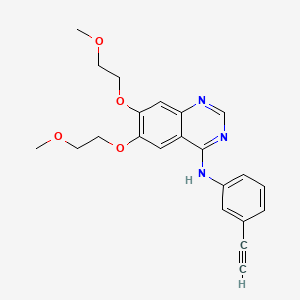Erlotinib, 183321-74-6, N-(3-Ethynylphenyl)-6,7-bis(2-methoxyethoxy)quinazolin-4-amine, Tarceva, Erlotinib free base, 4-Quinazolinamine, N-(3-ethynylphenyl)-6,7-bis(2-methoxyethoxy)-, OSI-774, 4-[(3-Ethynylphenyl)amino]-6,7-bis(2-methoxyethoxy)quinazoline, erlotinibum, N-(3-Ethynylphenyl)-6,7-bis(2-methoxyethoxy)-4-quinazolinamine, UNII-J4T82NDH7E, J4T82NDH7E, DTXSID8046454, Erlotinib, Free Base, HSDB 8082, OSI 744, CHEBI:114785, CP-358,774, 183321-74-6 (free base), CHEMBL553, RG-1415, [6,7-BIS(2-METHOXY-ETHOXY)QUINAZOLINE-4-YL]-(3-ETHYNYLPHENYL)AMINE, CP-358774, DTXCID6026454, CP-35877401, NSC 718781, R 1415, R-1415, MFCD02089651, NCGC00164574-01, [6,7-Bis-(2-methoxy-ethoxy)-quinazolin-4-yl]-(3-ethynyl-phenyl)-amine, Erlotinib(Tarceva), 1429636-49-6, CAS-183321-74-6, Erlotinib [INN:BAN], SR-05000001460, CP358774, Erotinib, (6,7-bis(2-methoxy-ethoxy)quinazoline-4-yl)-(3-ethynylphenyl)amine, (6,7-Bis-(2-methoxy-ethoxy)-quinazolin-4-yl)-(3-ethynyl-phenyl)-amine, nchembio866-comp3, Erlotinib free base?, Kinome_3317, n-(3-ethynylphenyl)-6,7-bis(2-methoxyethoxy)-4-quinazolinamine monohydrochloride, ERLOTINIB [MI], ERLOTINIB [VANDF], ERLOTINIB [WHO-DD], SCHEMBL8413, ERLOTINIB [EMA EPAR], BDBM5446, cid_176870, GTPL4920, L01XE03, AAKJLRGGTJKAMG-UHFFFAOYSA-N, HMS2089F05, HMS3244M19, HMS3244M20, HMS3244N19, HMS3295A19, HMS3713C22, HMS3745M05, Tox21_112202, AC-399, NSC800097, s7786, STK623143, AKOS000282911, Tox21_112202_1, CCG-220420, CS-0620, DB00530, NSC-800097, Ro-508231, SB16916, NCGC00164574-03, NCGC00164574-05, NCGC00164574-06, NCGC00164574-14, NCGC00164574-25, AS-35132, BCB03_000783, BE164419, HY-50896, SY028059, AM20090621, FT-0651539, NS00006169, EN300-708808, K00241, AB01273955-01, AB01273955-02, AB01273955-03, Q418369, SR-05000001460-1, SR-05000001460-2, SR-05000001460-3, SR-05000001460-6, BRD-K70401845-003-04-7, Z2588038919



